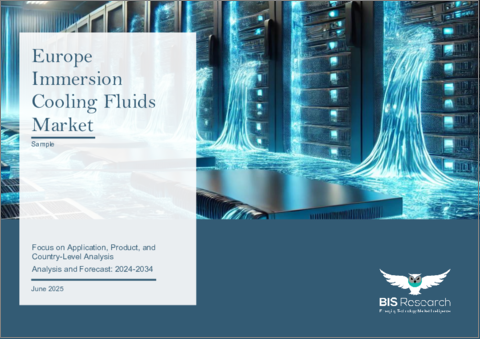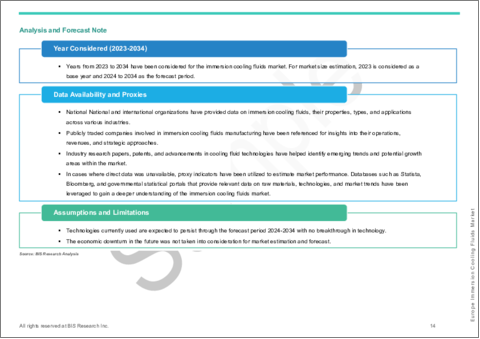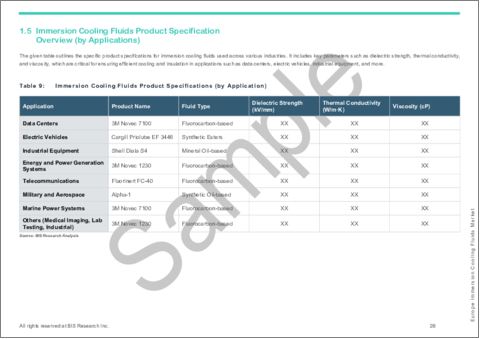|
|
市場調査レポート
商品コード
1756526
欧州の浸漬冷却液市場:用途別、製品別、国別 - 分析と予測(2024年~2034年)Europe Immersion Cooling Fluids Market: Focus on Application, Product, and Country-Level Analysis - Analysis and Forecast, 2024-2034 |
||||||
カスタマイズ可能
|
|||||||
| 欧州の浸漬冷却液市場:用途別、製品別、国別 - 分析と予測(2024年~2034年) |
|
出版日: 2025年06月26日
発行: BIS Research
ページ情報: 英文 98 Pages
納期: 1~5営業日
|
全表示
- 概要
- 図表
- 目次
欧州の浸漬冷却液の市場規模は、2024年に6,679万米ドルとなりました。
同市場は、28.49%のCAGRで拡大し、2034年には8億1,888万米ドルに達すると予測されています。欧州の浸漬冷却液市場は、電気自動車、データセンター、高度な電子機器に対する厳しいエネルギー効率規制によって牽引されています。優れた熱管理、消費電力の削減、機器寿命の延長はすべて誘電流体によってもたらされ、欧州の電力網の需要が高まるにつれて不可欠なものとなっています。EUの持続可能性インセンティブに支えられたリサイクル可能で低GWP処方の革新により、採用が加速しています。無電解冷却は、戦略的研究開発費と、流体メーカーとハイパースケールオペレーターのコラボレーションにより、欧州の高性能、低炭素の未来のための重要な技術として位置づけられています。
| 主要市場統計 | |
|---|---|
| 予測期間 | 2024年~2034年 |
| 2024年評価 | 6,679万米ドル |
| 2034年予測 | 8億1,888万米ドル |
| CAGR | 28.49% |
市場イントロダクション
データセンター、電子機器メーカー、電気自動車メーカーからの熱管理ソリューションの改善要求は、厳しいエネルギー効率と持続可能性の目標を達成するために、欧州の浸漬冷却液市場の成長を促進しています。サーバーモジュールや電子部品を、従来の空気または液体対空気システムよりも効率的に熱を吸収・伝達する誘電体流体に直接浸すことで、液浸冷却が実現します。欧州のFit for 55およびエネルギー効率指令の要件からプレッシャーを受けているハイパースケールデータセンターにとって、この技術は3つの主要な利点(低い電力使用効率(PUE)、冷凍機の必要性の減少、およびより静かな動作)を提供します。
生分解性エステルや低GWPフルオロカーボンなど、RoHS、REACH、F-Gas基準を遵守しながら環境への影響を最小限に抑える流体化学の進歩は、重要な推進力となっています。モジュール式液浸システムは、通信交換、エッジサイト、高性能コンピューティングクラスターや自動車インバーター冷却などの特殊な用途への柔軟な展開を可能にします。政府のインセンティブやカーボンクレジット制度により、早期導入のリスクは軽減されつつあり、流体調合メーカー、OEM、クラウドプロバイダーの戦略的パートナーシップにより、製品検証は迅速化されています。EU加盟国が送電網の耐障害性に投資し、クリーン技術の使用にインセンティブを与える中、無電解冷却液は、欧州の高密度・低炭素エレクトロニクスインフラへのシフトにおいて重要な要素になりつつあります。
市場セグメンテーション
セグメンテーション1:用途別
- データセンター
- ハイパースケール
- コロケーション
- エンタープライズ
- その他
- 電気自動車
- 乗用車
- 商用車
- 産業機器
- エネルギー・発電システム
- 通信機器
- 軍事・航空宇宙
- 舶用電力システム
- その他
セグメンテーション2:化学分野別
- フルオロカーボンベース浸漬冷却液
- 鉱物油ベースの浸漬冷却液
- 合成エステル
- 水性液
- その他
セグメンテーション3:製品別
- 単相クーラント
- 二相クーラント
セグメント4:地域別
- 欧州ドイツ、フランス、英国、イタリア、オランダ、アイルランド、その他
欧州の無電解冷却液市場動向と促進要因・課題
市場動向
- F-GasおよびREACH基準に準拠した低GWP、生分解性誘電体流体へのシフト
- HPCやAIクラスタにおける高熱流束用途での二相浸漬の採用拡大
- リアルタイム流体監視センサーと予知保全分析の統合
- エッジサイトやハイパースケールサイトへの迅速な導入を可能にする、モジュール式のラックレベルおよびシャーシレベルのシステム
- 流体製剤メーカーとクラウドプロバイダーの戦略的提携別、カスタマイズされた冷却ソリューションの共同開発
主な促進要因
- EUのエネルギー効率に関する指令(Fit for 55、エネルギー効率指令)により、データセンターはPUEの削減を迫られている
- AI、5Gエッジ、通信インフラにおける高密度コンピューティング需要の高まり
- コンパクトで効率的な熱管理のための液浸を活用した電気自動車のパワーエレクトロニクス冷却ニーズ
- 政府のインセンティブと炭素クレジット制度がパイロットプロジェクトと初期の商業展開のリスクを軽減
- サーキュラー・エコノミー(循環型経済)重視別セカンドライフとリサイクル可能な流体配合の推進
市場の課題
- 液浸対応ITハードウェアとインフラ改造のための高額な初期費用
- 腐食や絶縁破壊を防ぐための複雑な流体適合性試験と材料適合性試験
- EU加盟国間で統一された技術基準とベストプラクティスの欠如
- 誘電性流体を取り扱うための特別なメンテナンスの必要性と安全プロトコル
- 新しい流体化学物質や限られたリサイクル/再生施設に対するサプライチェーンの制約
製品/イノベーション戦略:欧州の浸漬冷却液市場の製品分野では、データセンター、高性能コンピューティング、電気自動車など、各産業における様々な用途を取り上げます。コンパクトで高密度なシステムの放熱を効率的に管理するように設計された先進的な冷却液が含まれます。主要技術には、冷却効率を向上させエネルギー消費を削減する、特別に配合された熱伝導性流体が含まれます。エネルギー効率の高い持続可能な冷却ソリューションへの需要が高まる中、浸漬冷却液市場は、流体技術の革新と、高性能化する電子システムにおける最適化された熱管理の必要性により、高い成長機会をもたらす可能性があります。
成長/マーケティング戦略:欧州の浸漬冷却液市場は急速に拡大しており、既存および新興市場参入企業に大きな機会を提供しています。主な戦略としては、M&A、製品投入、パートナーシップ、提携、事業拡大などが挙げられます。この市場に参入している企業は、市場ポジションを維持・強化するため、製品の革新と開発に注力する傾向にあります。
競合戦略:当レポートでは、技術プロバイダーを含む欧州の浸漬冷却液市場における主要企業プロファイルを掲載しています。提携、合意、協力関係を含む競合情勢を包括的に把握することができ、読者が同市場における未開拓の収益機会を特定するのに役立ちます。
当レポートでは、欧州の浸漬冷却液市場について調査し、市場の概要とともに、用途別、製品別、国別の動向、および市場に参入する企業のプロファイルなどを提供しています。
目次
エグゼクティブサマリー
第1章 市場:業界展望
- 浸漬冷却液市場:現状と将来
- 熱伝達流体と次世代材料の進歩
- 電気自動車販売の増加
- 再生可能エネルギーソリューションとの統合
- サプライチェーンの概要
- バリューチェーン分析
- 浸漬冷却液市場における供給者
- 研究開発レビュー
- 特許出願動向(国別・企業別)
- 規制状況
- 浸漬冷却液に影響を与える政府規制
- 流体に関する環境規制とその影響
- 将来の政策変更と勧告
- 浸漬冷却液製品仕様概要(用途別)
- 浸漬冷却液の化学と組成
- 浸漬冷却液の化学的性質
- 熱伝導率と熱伝達特性
- 流体の安定性と寿命
- 環境と安全に関する考慮事項
- 粘度、密度、その他の性能仕様
- PFAS禁止シナリオ
- PFASが浸漬冷却液に与える影響
- 将来の政策変更と勧告
- 3MのPFAS禁止への対応と浸漬冷却液市場への影響
- 市場力学:概要
- 市場促進要因
- 市場抑制要因
- 市場機会
第2章 地域
- 浸漬冷却液市場(地域別)
- 欧州
- 市場
- 応用
- 製品
- 欧州(国別)
第3章 市場-競合ベンチマーキングと企業プロファイル
- 今後の見通し
- 市場シェア分析
- 競合ベンチマーキング
- 製品価格の動向と分析
- 浸漬冷却液の価格に影響を与える要因
- 浸漬冷却液と従来の冷却方法の費用対効果分析
- 浸漬冷却液の主要エンドユーザー企業
- 競合のベンチマーク
- 浸漬冷却液市場における主要競合(用途別)
- 革新的な製品と次世代の浸漬冷却液
- スタートアップ分析
- 浸漬冷却液市場への新規参入企業
- 企業プロファイル
- FUCHS
- Submer
- Solvay
- Shell
- TotalEnergies
- Castrol Limited
- その他
第4章 調査手法
List of Figures
- Figure 1: Europe Immersion Cooling Fluids Market (by Scenario), $Million, 2023, 2027, and 2034
- Figure 2: Immersion Cooling Fluids Market (by Region), $Million, 2023, 2027, and 2034
- Figure 3: Europe Immersion Cooling Fluids Market (by Application), $Million, 2023, 2027, and 2034
- Figure 4: Europe Immersion Cooling Fluids Market (by Chemistry), $Million, 2023, 2027, and 2034
- Figure 5: Europe Immersion Cooling Fluids Market (by Product), $Million, 2023, 2027, and 2034
- Figure 6: Key Events
- Figure 7: Companies Advancing Immersion Cooling Solutions
- Figure 8: Global Electric Car Market Share, %, 2023
- Figure 9: Global Electric Car Stock, Millions, 2020-2023
- Figure 10: Supply Chan and Risks within the Supply Chain
- Figure 11: Value Chain Analysis
- Figure 12: Patent Analysis (by Country), January 2021-February 2025
- Figure 13: Patent Analysis (by Company), January 2021-February 2025
- Figure 14: Impact Analysis of Market Navigating Factors, 2024-2034
- Figure 15: Energy Consumption Breakdown in AI Data Centers
- Figure 16: Comparison between Conventional and AI Workloads
- Figure 17: Renewable energy demand growth (by Electricity), in EJ, 2023-2030
- Figure 18: Share of Total 5G Mobile Connections (by Region), 2023 and 2030
- Figure 19: U.K. Immersion Cooling Fluids Market, $Million, 2023-2034
- Figure 20: Germany Immersion Cooling Fluids Market, $Million, 2023-2034
- Figure 21: France Immersion Cooling Fluids Market, $Million, 2023-2034
- Figure 22: Italy Immersion Cooling Fluids Market, $Million, 2023-2034
- Figure 23: Netherlands Immersion Cooling Fluids Market, $Million, 2023-2034
- Figure 24: Ireland Immersion Cooling Fluids Market, $Million, 2023-2034
- Figure 25: Rest-of-Europe Immersion Cooling Fluids Market, $Million, 2023-2034
- Figure 26: Strategic Initiatives, January 2021-March 2025
- Figure 27: Estimated Capital Expense for Various Data Center Cooling Technologies
- Figure 28: Data Triangulation
- Figure 29: Top-Down and Bottom-Up Approach
- Figure 30: Assumptions and Limitations
List of Tables
- Table 1: Market Snapshot
- Table 2: Opportunities across Region
- Table 3: Competitive Landscape Snapshot
- Table 4: Trends: Overview
- Table 5: Comparison Between Conventional and Next-Generation Immersion Cooling Fluids
- Table 6: Government Regulations Impacting Immersion Cooling Fluids
- Table 7: Environmental Regulatory Landscape for Fluids
- Table 8: Industry Certifications and Standards for Immersion Cooling Fluids
- Table 9: Immersion Cooling Fluids Product Specifications (by Application)
- Table 10: Regulatory Landscape for PFAS Ban Scenario
- Table 11: Regulatory Landscape for Future Policy Changes and Recommendations
- Table 12: 3M's PFAS-Based Immersion Cooling Fluids: Key Products and Applications
- Table 13: Immersion Cooling Fluids Market (by Region), $Million, 2023-2034
- Table 14: Europe Immersion Cooling Fluids Market (by Application), $Million, 2023-2034
- Table 15: Europe Immersion Cooling Fluids Market (by Chemistry), $Million, 2023-2034
- Table 16: Europe Immersion Cooling Fluids Market (by Product Type), $Million, 2023-2034
- Table 17: U.K. Immersion Cooling Fluids Market (by Application), $Million, 2023-2034
- Table 18: U.K. Immersion Cooling Fluids Market (by Chemistry), $Million, 2023-2034
- Table 19: U.K. Immersion Cooling Fluids Market (by Product Type), $Million, 2023-2034
- Table 20: Germany Immersion Cooling Fluids Market (by Application), $Million, 2023-2034
- Table 21: Germany Immersion Cooling Fluids Market (by Chemistry), $Million, 2023-2034
- Table 22: Germany Immersion Cooling Fluids Market (by Product Type), $Million, 2023-2034
- Table 23: France Immersion Cooling Fluids Market (by Application), $Million, 2023-2034
- Table 24: France Immersion Cooling Fluids Market (by Chemistry), $Million, 2023-2034
- Table 25: France Immersion Cooling Fluids Market (by Product Type), $Million, 2023-2034
- Table 26: Italy Immersion Cooling Fluids Market (by Application), $Million, 2023-2034
- Table 27: Italy Immersion Cooling Fluids Market (by Chemistry), $Million, 2023-2034
- Table 28: Italy Immersion Cooling Fluids Market (by Product Type), $Million, 2023-2034
- Table 29: Netherlands Immersion Cooling Fluids Market (by Application), $Million, 2023-2034
- Table 30: Netherlands Immersion Cooling Fluids Market (by Chemistry), $Million, 2023-2034
- Table 31: Netherlands Immersion Cooling Fluids Market (by Product Type), $Million, 2023-2034
- Table 32: Ireland Immersion Cooling Fluids Market (by Application), $Million, 2023-2034
- Table 33: Ireland Immersion Cooling Fluids Market (by Chemistry), $Million, 2023-2034
- Table 34: Ireland Immersion Cooling Fluids Market (by Product Type), $Million, 2023-2034
- Table 35: Rest-of-Europe Immersion Cooling Fluids Market (by Application), $Million, 2023-2034
- Table 36: Rest-of-Europe Immersion Cooling Fluids Market (by Chemistry), $Million, 2023-2034
- Table 37: Rest-of-Europe Immersion Cooling Fluids Market (by Product Type), $Million, 2023-2034
- Table 38: Market Share, 2023
- Table 39: Influencing Factors for Immersion Cooling Fluid Prices
- Table 40: Key End User Companies for Immersion Cooling Fluids
- Table 41: List of Key Competitors in Immersion Cooling Fluids Market
- Table 42: List of Innovative Products for Immersion Cooling Fluids Market
- Table 43: List of New Companies in Immersion Cooling Fluids Market
This report can be delivered in 2 working days.
Introduction to Europe Immersion Cooling Fluids Market
The Europe immersion cooling fluids market was valued at $66.79 million in 2024 and is expected to grow at a CAGR of 28.49%, reaching $818.88 million by 2034. The market for immersion cooling fluids in Europe is being driven by strict energy-efficiency regulations for electric cars, data centres, and sophisticated electronics. Superior thermal management, reduced power consumption, and longer equipment lifespans are all provided by dielectric fluids, which are essential as demand on European power networks rises. Adoption is speeding up thanks to innovations in recyclable and low-GWP formulations supported by EU sustainability incentives. Immersion cooling is being positioned as a key technology for Europe's high-performance, low-carbon future through strategic R&D expenditures and collaborations between fluid makers and hyperscale operators.
| KEY MARKET STATISTICS | |
|---|---|
| Forecast Period | 2024 - 2034 |
| 2024 Evaluation | $66.79 Million |
| 2034 Forecast | $818.88 Million |
| CAGR | 28.49% |
Market Introduction
The demand for improved thermal management solutions from data centres, electronics makers, and electric vehicle manufacturers is driving growth in Europe's immersion cooling fluids market in order to achieve strict energy-efficiency and sustainability targets. By directly immersing server modules or electronic components in dielectric fluids, which absorb and transfer heat more efficiently than traditional air or liquid-to-air systems, immersion cooling is achieved. For hyperscale data centres under pressure from Europe's Fit for 55 and Energy Efficiency Directive requirements, this technology offers three major benefits: lower power usage effectiveness (PUE), less need on chillers, and quieter operation.
Advances in fluid chemistry, such as biodegradable esters and low-GWP fluorocarbons that minimise environmental effect while adhering to RoHS, REACH, and F-Gas standards, are important drivers. Modular immersion systems allow for flexible deployment at telecom exchanges, edge sites, and specialised applications such as high-performance computing clusters and automotive inverter cooling. Early installations are becoming less risky because to government incentives and carbon-credit programs, and product validation is being expedited by strategic partnerships among fluid formulators, OEMs, and cloud providers. Immersion cooling fluids are becoming a key component of Europe's shift to high-density, low-carbon electronics infrastructure as EU member states make investments in grid resilience and provide incentives for the use of clean technologies.
Market Segmentation:
Segmentation 1: by Application
- Data Center
- Hyperscale
- Colocation
- Enterprise
- Others
- Electric Vehicles
- Passenger Vehicles
- Commercial Vehicles
- Industrial Equipment
- Energy and Power Generation Systems
- Telecommunications
- Military and Aerospace
- Marine Power Systems
- Others
Segmentation 2: by Chemistry
- Fluorocarbon-Based Immersion Cooling Fluids
- Mineral Oil-Based Immersion Cooling Fluids
- Synthetic Esters
- Water-Based Fluids
- Others
Segmentation 3: by Product
- Single-Phase Coolant
- Two-Phase Coolant
Segmentation 4: by Region
- Europe: Germany, France, U.K., Italy, Netherlands, Ireland, and Rest-of-Europe
Europe Immersion Cooling Fluids Market Trends, Drivers and Challenges
Market Trends
- Shift toward low-GWP, biodegradable dielectric fluids compliant with F-Gas and REACH standards
- Growing adoption of two-phase immersion for higher heat flux applications in HPC and AI clusters
- Integration of real-time fluid-monitoring sensors and predictive maintenance analytics
- Modular rack-level and chassis-level systems enabling rapid deployment at edge and hyperscale sites
- Strategic alliances between fluid formulators and cloud providers to co-develop tailored cooling solutions
Key Drivers
- EU energy-efficiency mandates (Fit for 55, Energy Efficiency Directive) pushing data centers to reduce PUE
- Rising demand for high-density computing in AI, 5G edge, and telecom infrastructure
- Electric vehicle power-electronics cooling needs leveraging immersion for compact, efficient thermal management
- Government incentives and carbon-credit schemes de-risking pilot projects and early commercial roll-outs
- Circular-economy focus driving second-life and recyclable fluid formulations
Market Challenges
- High upfront costs for immersion-ready IT hardware and infrastructure modifications
- Complex fluid compatibility and material-compatibility testing to prevent corrosion or dielectric breakdown
- Lack of unified technical standards and best practices across EU member states
- Specialized maintenance needs and safety protocols for handling dielectric fluids
- Supply-chain constraints for novel fluid chemistries and limited recycling/regeneration facilities
How can this report add value to an organization?
This report can add value to an organization in several ways. Some of these are given here:
Product/Innovation Strategy: The product segment of the Europe immersion cooling fluids market highlights various applications across industries, such as data centers, high-performance computing, and electric vehicles. It includes advanced cooling fluids designed to efficiently manage heat dissipation in compact, high-density systems. Key technologies involve specially formulated thermally conductive fluids, which improve cooling efficiency and reduce energy consumption. As the demand for energy-efficient, sustainable cooling solutions rises, the immersion cooling fluids market could present a high-growth opportunity driven by innovations in fluid technology and the need for optimized thermal management in increasingly powerful electronic systems.
Growth/Marketing Strategy: The Europe immersion cooling fluids market is rapidly expanding, offering substantial opportunities for both established and emerging market players. Key strategies covered include mergers and acquisitions, product launches, partnerships, collaborations, and business expansions. Companies in this market tend to focus on product innovation and development to maintain and strengthen their market position.
Competitive Strategy: The report profiles key players in the Europe immersion cooling fluids market, including technology providers. It offers a comprehensive view of the competitive landscape, including partnerships, agreements, and collaborations, helping readers identify untapped revenue opportunities in the market.
Key Market Players and Competition Synopsis
The companies profiled in the Europe immersion cooling fluids market have been selected based on inputs gathered from primary experts and analyzing company coverage, product portfolio, and market penetration.
Some of the prominent names in this market are:
- FUCHS
- Submer
- Solvay
- Shell
- TotalEnergies
- Castrol Limited
Table of Contents
Executive Summary
Scope and Definition
1 Market: Industry Outlook
- 1.1 Immersion Cooling Fluids Market: Current and Future
- 1.1.1 Advancements in Heat Transfer Fluids and Next-Generation Materials
- 1.1.2 Increase in Electric Vehicle Sales
- 1.1.3 Integration with Renewable Energy Solutions
- 1.2 Supply Chain Overview
- 1.2.1 Value Chain Analysis
- 1.2.2 Who Supplies Whom for Immersion Cooling Fluids Market
- 1.3 Research and Development Review
- 1.3.1 Patent Filing Trend (by Country and Company)
- 1.4 Regulatory Landscape
- 1.4.1 Government Regulations Impacting Immersion Cooling Fluids
- 1.4.2 Environmental Regulations for Fluids and Their Impact
- 1.4.3 Future Policy Changes and Recommendations
- 1.5 Immersion Cooling Fluids Product Specification Overview (by Applications)
- 1.6 Immersion Cooling Fluids Chemistry and Composition
- 1.6.1 Chemical Properties of Immersion Cooling Fluids
- 1.6.2 Thermal Conductivity and Heat Transfer Characteristics
- 1.6.3 Fluid Stability and Longevity
- 1.6.4 Environmental and Safety Considerations
- 1.6.5 Viscosity, Density, and Other Performance Specifications
- 1.7 PFAS Ban Scenario
- 1.7.1 Impact of PFAS on Immersion Cooling Fluids
- 1.7.2 Future Policy Changes and Recommendations
- 1.7.3 3M's Response to the PFAS Ban and Its Impact on the Immersion Cooling Fluids Market
- 1.8 Market Dynamics: Overview
- 1.8.1 Market Drivers
- 1.8.1.1 Rising Enterprise Adoption of Data Center GPUs for High-Performance Computing Applications
- 1.8.1.2 Increasing Focus on Retrofitting and Brownfield Projects
- 1.8.2 Market Restraints
- 1.8.2.1 Increased Costs Arising from System Failures and Fluid Leaks
- 1.8.2.2 Negative Environmental Concerns about Fluorocarbons
- 1.8.3 Market Opportunities
- 1.8.3.1 Global Expansion of Renewable Energy Projects
- 1.8.3.2 Advancements in 5G and 6G Technologies
- 1.8.1 Market Drivers
2 Regions
- 2.1 Immersion Cooling Fluids Market (by Region)
- 2.2 Europe
- 2.2.1 Market
- 2.2.1.1 Key Market Participants in Europe
- 2.2.1.2 Business Drivers
- 2.2.1.3 Business Challenges
- 2.2.2 Application
- 2.2.3 Product
- 2.2.4 Europe (by Country)
- 2.2.4.1 U.K.
- 2.2.4.1.1 Application
- 2.2.4.1.2 Product
- 2.2.4.2 Germany
- 2.2.4.2.1 Application
- 2.2.4.2.2 Product
- 2.2.4.3 France
- 2.2.4.3.1 Application
- 2.2.4.3.2 Product
- 2.2.4.4 Italy
- 2.2.4.4.1 Application
- 2.2.4.4.2 Product
- 2.2.4.5 Netherlands
- 2.2.4.5.1 Application
- 2.2.4.5.2 Product
- 2.2.4.6 Ireland
- 2.2.4.6.1 Application
- 2.2.4.6.2 Product
- 2.2.4.7 Rest of Europe
- 2.2.4.7.1 Application
- 2.2.4.7.2 Product
- 2.2.4.1 U.K.
- 2.2.1 Market
3 Markets - Competitive Benchmarking & Company Profiles
- 3.1 Next Frontiers
- 3.1.1 Market Share Analysis
- 3.1.2 Competitive Benchmarking
- 3.2 Product Pricing Trends and Analysis
- 3.2.1 Factors Influencing Immersion Cooling Fluids Pricing
- 3.2.2 Cost-Benefit Analysis of Immersion Cooling Fluids vs. Traditional Cooling Methods
- 3.3 Key End User Companies for Immersion Cooling Fluids
- 3.4 Competitor Benchmarking
- 3.4.1 Key Competitors in Immersion Cooling Fluids Market (by Application)
- 3.4.2 Innovative Products and Next-Generation Immersion Cooling Fluids
- 3.5 Startup Analysis
- 3.5.1 New Entrants in the Immersion Cooling Fluids Market
- 3.6 Company Profiles
- 3.6.1 FUCHS
- 3.6.1.1 Overview
- 3.6.1.2 Top Products/Product Portfolio
- 3.6.1.3 Top Competitors
- 3.6.1.4 End-Use Applications
- 3.6.1.5 Key Personnel
- 3.6.1.6 Analyst View
- 3.6.1.7 Market Share, 2023
- 3.6.2 Submer
- 3.6.2.1 Overview
- 3.6.2.2 Top Products/Product Portfolio
- 3.6.2.3 Top Competitors
- 3.6.2.4 End-Use Applications
- 3.6.2.5 Key Personnel
- 3.6.2.6 Analyst View
- 3.6.2.7 Market Share, 2023
- 3.6.3 Solvay
- 3.6.3.1 Overview
- 3.6.3.2 Top Products/Product Portfolio
- 3.6.3.3 Top Competitors
- 3.6.3.4 End-Use Applications
- 3.6.3.5 Key Personnel
- 3.6.3.6 Analyst View
- 3.6.3.7 Market Share, 2023
- 3.6.4 Shell
- 3.6.4.1 Overview
- 3.6.4.2 Top Products/Product Portfolio
- 3.6.4.3 Top Competitors
- 3.6.4.4 End-Use Applications
- 3.6.4.5 Key Personnel
- 3.6.4.6 Analyst View
- 3.6.4.7 Market Share, 2023
- 3.6.5 TotalEnergies
- 3.6.5.1 Overview
- 3.6.5.2 Top Products/Product Portfolio
- 3.6.5.3 Top Competitors
- 3.6.5.4 End-Use Applications
- 3.6.5.5 Key Personnel
- 3.6.5.6 Analyst View
- 3.6.5.7 Market Share, 2023
- 3.6.6 Castrol Limited
- 3.6.6.1 Overview
- 3.6.6.2 Top Products/Product Portfolio
- 3.6.6.3 Top Competitors
- 3.6.6.4 End-Use Applications
- 3.6.6.5 Key Personnel
- 3.6.6.6 Analyst View
- 3.6.6.7 Market Share, 2023
- 3.6.7 Other Key Players
- 3.6.1 FUCHS
4 Research Methodology
- 4.1 Data Sources
- 4.1.1 Primary Data Sources
- 4.1.2 Secondary Data Sources
- 4.1.3 Data Triangulation
- 4.2 Market Estimation and Forecast






